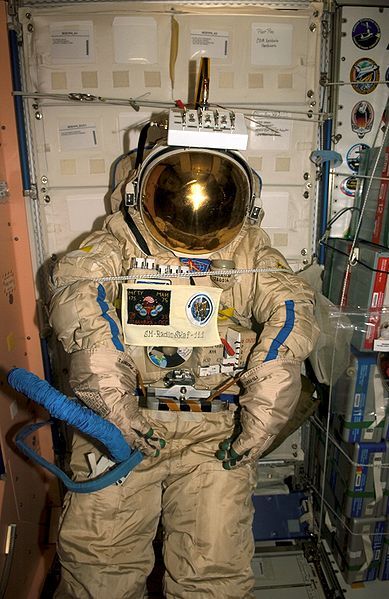 The following is an article from Uncle John's 24-Karat Gold Bathroom Reader.
The following is an article from Uncle John's 24-Karat Gold Bathroom Reader.
They don't have used clothing stores in space, so what's an astronaut to do when his space suit wears out? Here's the story of the space suit that talked back after it was thrown over the side.
THE WELL-DRESSED ASTRONAUT
If you're like Uncle John, you like to wear your old jeans, t-shirts, and sweatshirts until they're tattered and riddled with holes. You can get away with that on Earth, but not in space: The spacesuits that NASA astronauts and Russian cosmonauts use can't be worn until they're full of holes, because their not having holes is what keeps the astronauts alive. Millions of dollars are spent designing and building the suits used on the International Space Station, yet most are used only a dozen times before they need to be completely refurbished or retired from service.
Then what? During the space shuttle era, NASA spacesuits could be returned to Earth aboard the shuttle and overhauled; now they're discarded the same way that the Russian Orlan spacesuits are: via the unmanned Progress spacecraft that resupply the ISS three or four times a year. After supplies are unloaded from the Progress capsule, it's stuffed with space garbage from the ISS: empty food containers, dirty clothes (the ISS doesn't have a washing machine), old spacesuits, and other refuse. Then the capsule is set adrift in orbit, where it will eventually burn up as it re-enters Earth's atmosphere. The shooting star you saw the other night? It might have been a flaming ISS garbage can.
TALKING TRASH
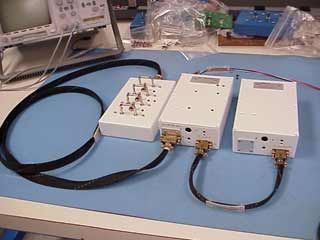 On more than one occasion, the astronauts have used the space suits themselves as trash cans, cramming them full of garbage, hauling them out the airlock, and shoving them off the back of the ISS into space. In 2004 a Russian research team led by engineer Segei Samburov took the concept a little further: Since anything tossed out of the ISS will orbit the Earth for a few months until it re-enters the atmosphere, they decided to turn an old Orlan spacesuit into a cheap communications satellite by outfitting it with a microprocessor and an amateur ("ham") radio walkie-talkie.
On more than one occasion, the astronauts have used the space suits themselves as trash cans, cramming them full of garbage, hauling them out the airlock, and shoving them off the back of the ISS into space. In 2004 a Russian research team led by engineer Segei Samburov took the concept a little further: Since anything tossed out of the ISS will orbit the Earth for a few months until it re-enters the atmosphere, they decided to turn an old Orlan spacesuit into a cheap communications satellite by outfitting it with a microprocessor and an amateur ("ham") radio walkie-talkie.
ARISS-TED DEVELOPMENT
Samburov and his colleagues were members of the Russian chapter of Amateur Radio on the International Space Station (ARISS). The group was responsible for getting a ham radio station installed on the ISS. Members train astronauts to use the station before they leave Earth, and then arrange for space-to-Earth contacts with school assemblies, science museums, scouting organizations, and other community groups on the ground. It's all done with the purpose of encouraging people -especially young people- to take an interest in science, engineering, and mathematics.
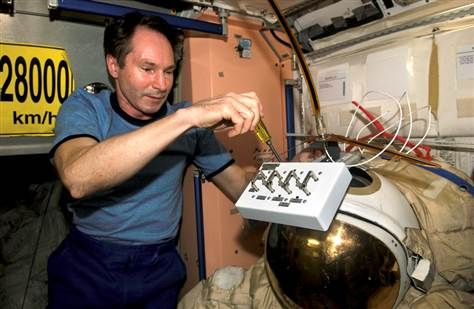 Working out the details of what the spacesuit satellite would do fell to the Russian and American sections of ARISS. (The Russians nicknamed it "Ivan Ivanov," the Americans called it "Mr. Smith," but its official name was "SuitSat-1.") Here's what they decided:
Working out the details of what the spacesuit satellite would do fell to the Russian and American sections of ARISS. (The Russians nicknamed it "Ivan Ivanov," the Americans called it "Mr. Smith," but its official name was "SuitSat-1.") Here's what they decided:
* After identifying itself and giving its call sign ("This is SuitSat-1, RS0RS"), the satellite would play one of five different prerecorded greetings made by students from Russia, the United States, France, Japan, and Germany.
* This would be followed by either a digital voice stating the satellite's temperature, battery power, and elapsed mission time (stored in the microprocessor) that could be downloaded onto any computer.
* Then SuitSat would pause for 30 seconds and begin transmitting again. The transmission would repeat continuously, cycling through the five recorded greetings until the batteries finally died.
* Each greeting contained a "secret" word that students were encouraged to translate into their own language by exchanging information with students from other parts of the world.
* The subject of the digital photograph was also secret; to find out what is was, the photograph had to be downloaded.
Any student who succeeded in receiving the SuitSat-1 transmissions was eligible to receive a commemorative certificate, with special recognition going to students who translated the secret words or downloaded the digital image. SuitSat-1 broadcast its signal over a ham radio frequency, 145.990 MHz. And because the signal would be coming from directly overhead, the transmission would be strong enough to give anyone with even the simplest police scanner or walkie-talkie tunable to ham radio frequencies a good chance at receiving the signal. The only trick was figuring out when SuitSat-1 was passing overhead, but that information was easy to get online.
MAN OF THE HOUR
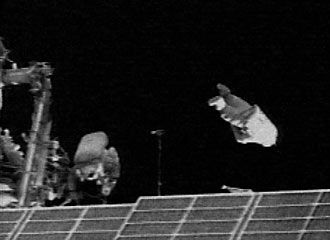 On September 10, 2005, a Progress resupply ship blasted off from Kazakhstan bound for the International Space Station. Among its cargo were the walkie-talkie and other components for SuitSat-1. After Progress arrived at the ISS, the astronauts assembled the components and placed them inside the body of the spacesuit. They attached an antenna and a control panel to the suit's helmet, then stuffed the suit full of dirty clothes to give it a more human form (and to get rid of the clothes).
On September 10, 2005, a Progress resupply ship blasted off from Kazakhstan bound for the International Space Station. Among its cargo were the walkie-talkie and other components for SuitSat-1. After Progress arrived at the ISS, the astronauts assembled the components and placed them inside the body of the spacesuit. They attached an antenna and a control panel to the suit's helmet, then stuffed the suit full of dirty clothes to give it a more human form (and to get rid of the clothes).
Then on February 3, 2006, at the start of a six-hour spacewalk, Russian cosmonaut Valery Tokarey eased SuitSat-1 out of the ISS airlock, switched it on, and gave it final shove. "Goodbye, Mr. Smith," he said as the spacesuit slowly floated away. Footage of the launch of SuitSat-1 can be found online, as can photographs of the SuitSat-1 floating above the Earth. The images are beautiful, but they're also kind of disturbing: SuitSat-1 looks like a dead astronaut drifting off into space.
(YouTube link)
HOUSTON, WE HAVE A PROBLEM
SuitSat-1 only completed a couple of orbits around Earth before it started to malfunction. Tokarey and his partner on the spacewalk, NASA astronaut Bill McArthur, weren't even back inside the space station before Mission Control in Houston reported that no more transmissions were being received from SuitSat-1.
It seemed like the satellite was dead ?until ham radio enthusiasts all over the world began picking up faint signals. They were much weaker than expected, but the SuitSat-1 was still on the air. There are different theories to account for SuitSat-1's troubles. The batteries may not have functioned properly in the intense cold of space. Or the radio might have somehow switched to a low power setting. Or the antenna, scrounged from parts on the ISS, may not have performed as wells expected, a problem made worse by the uncontrollable tumbling of the spacesuit.
Amazingly, instead of dying out in two or three days as expected, SuitSat-1 stayed on the air for a full two weeks before finally falling silent on February 18 as it passed over North America. SuitSat-1 drifted for another seven months before burning up on re-entry on September 7, 2006.
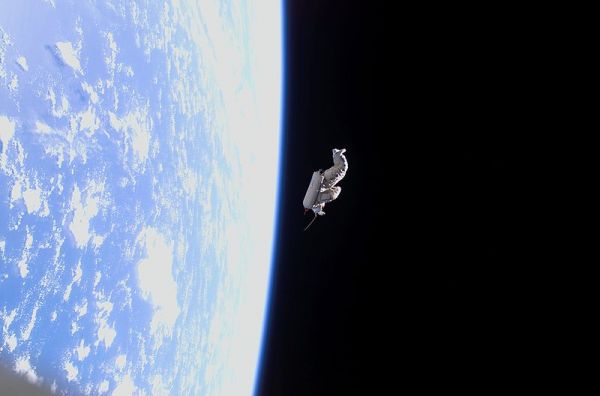
EMPTY SUIT
SuitSat-1 was successful enough for ARISS to want to try the idea again. The group made plans for a much-improved SuitSat-2, this time with rechargeable batteries (powered by solar panels attached to the legs of the suit), cameras transmitting live images of Earth instead of a single digital photograph, and a transponder that would allow ham radio enthusiasts in different parts of the world to talk to each other using SuitSat-2 as a relay.
But this was a SuitSat that would have no suit. In July 2009, the retired Orlan spacesuit that was set aside for the project had to be disposed of to free up room on the ISS for more important projects. Rather than wait for another suit to become available, ARISS built a metal box large enough to hold all of the SuitSat-2 components and used it instead. Renamed ARISSat-1, the satellite arrived at the ISS in January 2011 and was deployed during a spacewalk on August 3, 2011. It almost certainly won't be the last such satellite tossed out the back of the International Space Station. ARISS has a few more ARISSats assembled and ready to go for the next time an opportunity arises. "Tossing" may one day be a common (and cheap) method of putting satellites in orbit.
___________________
 The article above was reprinted with permission from Uncle John's 24-Karat Gold Bathroom Reader.
The article above was reprinted with permission from Uncle John's 24-Karat Gold Bathroom Reader.
Since 1988, the Bathroom Reader Institute had published a series of popular books containing irresistible bits of trivia and obscure yet fascinating facts. If you like Neatorama, you'll love the Bathroom Reader Institute's books - go ahead and check 'em out! 
Source: http://www.neatorama.com/2013/04/01/SuitSat-1-The-Garbage-Satellite/
Pope Resigns westminster dog show Christopher Dorner Manifesto mardi gras Christopher Dorner whitney houston Salwa Amin
No comments:
Post a Comment
Note: Only a member of this blog may post a comment.